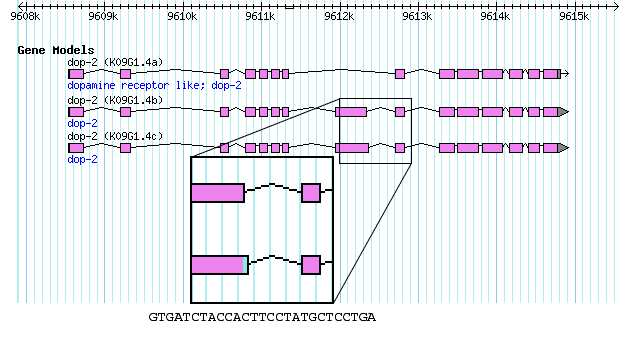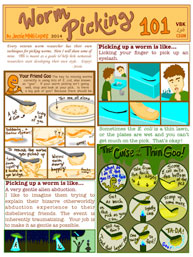Specific neurotransmitters, their receptors and ion channels localized to synaptic termini, play important roles in behavior and synaptic plasticity. Dopamine receptors, characterized by seven trans-membrane domains, are known to act through G-protein coupled pathways. In C. elegans, dopamine has been implicated in a variety of behavioral processes, including both non-associative and associative learning. The worm dop-2 gene represents a dopamine auto-receptor expressed in dopaminergic neurons (Suo et al., 2003). D2-like auto-receptors have been proposed to regulate the release of dopamine from the pre-synaptic neurons as well as reuptake by DAT (Williams and Galli, 2006; Voglis and Tavernarakis, 2008). We are interested in interacting partners of dop-2 and are using its gene product as bait in a ubiquitin-based yeast two hybrid screen.
In the process of reverse transcriptase PCR amplification of worm total RNA we serendipitously amplified an additional splice variant of dop-2, besides the 2 variants K09G1.4a and K09G1.4b (Suo et al., 2003). This third full-length mRNA (K09G1.4c, Figure-1) has 27 additional nucleotides at the 3’ end of exon-8 neighboring the exon:intron junction. The additional sequence codes for 9 amino-acids in the large intracellular loop between trans-membrane domains 5 and 6. The resulting motif (GDLPLPMLL) does not display similarity to any known motif through Pfam match. Interestingly, the regional splicing of all three variants including intron-7 and intron-8 is the conserved GC-AT junction sequence, and not GC-AG commonly found in splice variants in worms and humans (Farrer et al., 2002).
Figures
References
Farrer T, Roller AB, Kent WJ, Zahler AM. (2002). Analysis of the role of Caenorhabditis elegans GC-AG introns in regulated splicing. Nucl. Acids Res. 30, 3360-3367. 
Suo S, Sasagawa N, Ishiura S. (2003). Cloning and characterization of a Caenorhabditis elegans D2-like dopamine receptor. J. Neurochem. 86, 869-878. 
Williams JM, Galli A. (2006). The dopamine transporter: a vigilant border control for psychostimulant action. Handb. Exp. Pharmacol. 175, 215-232. 
oglis G, Tavernarakis N. (2008). A synaptic DEG/ENaC ion channel mediates learning in C. elegansby facilitating dopamine signaling. EMBO J. 27, 3288-3299. 





